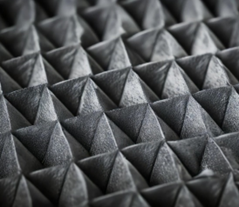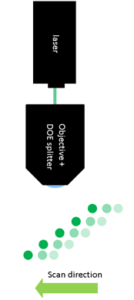Custom diffractive beam splitter plate enables rapid oxide etch mask texturing for innovative Solar Panels
Holo/Or is a member of the BURST consortium where we are responsible for the optics used to texture PV cells for improved efficiency. In this article we share some of the challenges in the optical design task for this interesting application.Introduction: Producing solar cells with improved efficiency by using a Beam splitter plate

The optical challenge of large area laser texturing
The ideal optical structure for photonic crystal aimed at maximizing light trapping in the PV cell is in the range 1.5-3.1µm. Thus, holes in the oxide mask layer must be opened with a similar pitch and the 515nm laser spot on the oxide must be of similar magnitude (1-2µm diameter). As the fluence needed to remove the oxide per hole is rather low, thousands of such holes can be simultaneously structured with a single laser pulse. The main challenge is that the energy cannot be spread by scanning over the field, as scanning optics do not typically reach a spot size of 1-2µm. The way to spread the energy is by using a diffractive beam splitter plate to generate an array of spot that will simultaneously structure multiple holes, and scanning this line using a fast stage.Diffractive beam splitters- principle of operation
A diffractive beam splitter plate is a flat optical component that splits an incoming laser beam into a fan of pre-defined output orders, each having a pre-defined fraction of the input energy and its own deflection angle. When focused by an external lens, this generates an array of spots with uniform separations, each having a profile identical to the spot created by the un-split input laser. Diffractive beam splitters are periodic phase gratings, typically transmissive, etched into a transparent material (fused silica in our case). Using advanced iterative algorithms, the phase is designed to maximize the efficiency of splitting to a certain diffraction order, while maintain uniform energy in the desired orders. Sometimes, a lens function is added to the diffractive grating, resulting in a beam splitter lens, but for large area laser oxide texturing, a special large field focuser must be used.Large field focuser for oxide on Si laser texturing

Possible texturing schemes
A straightforward scheme for texturing the oxide is a line of uniform spots scanner perpendicular to the line. However, due to inherent mutual interference constraints, designing a line of 2um spots with 3.1um will result in mutual interference between the spots, reducing intensity uniformity. To mitigate this, different spot patterns can be used, such as a staggered spot pattern where there is much less overlap between neighboring spots. Due to the inherent design flexibility of diffractive beam splitters, the same focusing system can be used with different beam splitter plates, resulting in different texturing patterns.Conclusion
Diffractive beam splitter plates can enable rapid laser texturing of oxide masks on PV material, creating hundreds of 2µm holes in the oxide with controlled separations over fields as large as 2mm. As this is a challenging optical task due to the large NA and field required, the refractive focusing objective must be designed around diffractive element requirements, so the system achieved its intended specs.TL; DR – Q&A SUMMARY
Why texture solar cells with inverse pyramid structures?
Laser Texturing of PV cells can increase light trapping in the material and thus increase efficiency, by creating a photonic crystal structure on top to the active Si layer.
What is the challenge in laser texturing of the oxide mask used to create the inverse pyramids?
The required spots are small (1-2µm) and dense (1.5-3.1µm pitch), so laser energy must be spread over a large number of spots to achieve industrially relevant texturing rates. This requires diffractive beam splitters plates and a special focuser.
What are diffractive beam splitters?
Diffractive beam splitter are transparent periodic phase gratings that split an incoming beam into multiple spots with controlled separations and power ratios. Typically, spots are designed to have uniform power.

